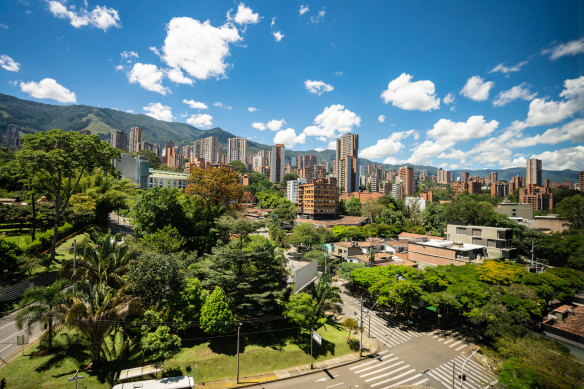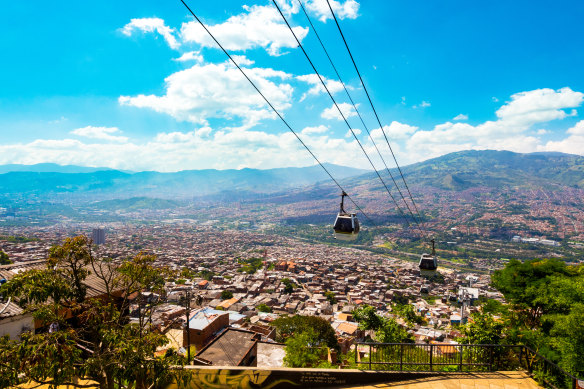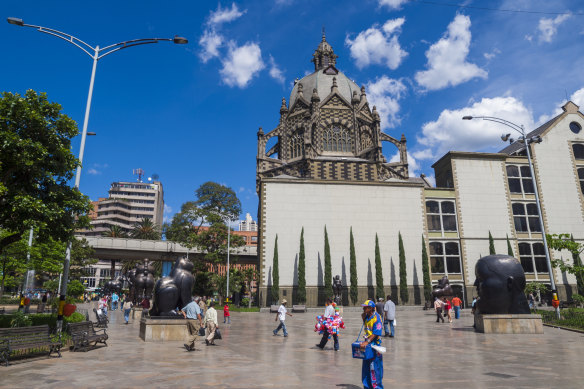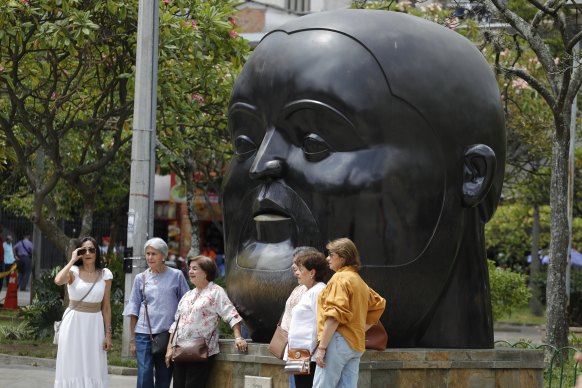The former ‘murder capital of the world’ is now overrun with tourists
By Andrea Jaramillo
Known as the murder capital of the world at the start of the ’90s, by the late 2000s Medellin, Colombia, had undergone a revival. As violence ebbed, it welcomed new investment and visitors from abroad. Backpackers roaming the streets became a common sight.
Today, tourism is surging. An explosion of newcomers since the pandemic has brought new restaurants, fancy shops and guided tours. But it is also driving up rents and drawing pushback from locals. As cities around the world struggle with the negative consequences of mass tourism, the wave of both short- and long-term visitors in Medellin is creating unique challenges because, experts say, it happened virtually overnight.

Medellin had a record 1.4 million visitors from overseas in 2022.Credit: iStock
“Everything that comes too fast and too big generates conflict,” said Alejandro Echeverri, an urban planning expert who played a crucial role in the city’s revival as the director of urban projects for the mayor’s office from 2004 to 2007. “In Spain, in Mexico and in many countries it has happened with great intensity and has those societies questioning what to do. But nowhere, I think, with the speed and impact that is occurring in Medellin.”
Last year, the city had a record 1.4 million visitors from overseas, mostly from the US, surpassing Cartagena for the first time. And since the pandemic ushered in the possibility of remote work for millions, digital nomads now sit tethered to their laptops in the cafes and co-working spaces that have sprouted up around the city. The Nomad List website, which includes recommendations for remote professionals, ranks Medellin as the top destination in Latin America after Buenos Aires and Mexico City.
“Medellin always intrigued me, so it was always in the back of my mind to come here,” says Rens de Bruijn, 32, who works as a project manager for a company based in his native Netherlands. Until relocating to Brazil earlier this summer, De Bruijn worked remotely from Medellin for several months. While the city is full of foreigners, “the culture, the food, the people are still very authentic,” he says. “You can see it’s ingrained through generations.”
Part of the city’s allure is in the spending power that foreigners enjoy: The Colombian peso slumped to record lows in 2022 (though it recently increased in value). Another part is captured in Medellin’s nickname: “The city of eternal spring”.

Medellin has a good public transport system, including cable cars.Credit: iStock
Nestled in a valley 1500 metres above sea level and surrounded by the Andes Mountains, Medellin boasts average temperatures of about 23 degrees year-round and is full of lush green vegetation. Its transport infrastructure, including a subway and a public bus system, makes it easy to get around.
The city’s history of violence has helped place it on the map. In the 1980s and early 1990s, infamous drug lord Pablo Escobar used Medellin as the base for his cartel, which controlled an estimated 60 per cent of the world’s cocaine supply. Turf battles with other trafficking groups and Escobar’s declared war on the Colombian state led to spiralling levels of violence, pushing the murder rate to a peak of 375 per 100,000 people in 1991.
Today, tourists are drawn to Medellin in part because of that harrowing past. The Netflix series Narcos and other popular media portrayals have raised awareness about the city for a generation born after the era of Escobar.
But they arrive to a vastly different place. Escobar was gunned down in 1993, and the disarming of some of the paramilitary groups in later years helped quell part of the violence. Investments in education and infrastructure also helped, says Natalia Castaño, head of EAFIT University’s Center for Urban and Environmental Studies. Today, the murder rate hovers around 15 per 100,000 residents — well below many Latin American and US cities. Libraries, cable cars and even escalators were constructed in the poorest and most violent parts of the city to help locals reach their steep hilltop homes. While it was not the main intention, these changes also began attracting visitors, Castaño said.

Plaza Botero in central Medellin. Some visitors are choosing to stay in the city long term.Credit: iStock
More and more of them are staying for months at a time. Kevin Ramsey, a Jamaican who works for a Miami-based e-commerce company, decided to make Medellin his home for most of the year. The time zone is only an hour apart from his employer’s and his family is less than a four-hour flight away, he says. Between April and July of this year, he rented four different apartments on Airbnb, giving him a chance to explore different areas in Medellin. The most expensive was $1800 for a month in a two-bedroom apartment, while the cheapest was $1250 per month for a one-bedroom. He is now considering buying a place of his own.
These rents may be inexpensive for those accustomed to pricey cities, but it’s another story for locals. Properties that were once available for yearly leases are now being advertised instead on rental platforms that cater to short- and medium-term stays. The number of listings available on Airbnb and Vrbo in Medellin jumped by 45 per cent to 12,372 in June from 8532 a year earlier, according to data from analytics site AirDNA.
Rents are shooting up. One of the barrios within Laureles – a high-income neighbourhood in Medellin which is a favourite for tourists and digital nomads because of its tree-lined sidewalks, parks and quieter streets – saw rent prices jump 80 per cent just in the first four months of 2023, according to Properati, an online property platform. That meant that the average monthly rent for a 70 square-metre apartment rose to 3.2 million pesos (about $1200) in April from 1.8 million pesos in January. That increase far exceeds the rate of inflation, and is way beyond what many workers can afford: Colombia’s minimum monthly wage stands at 1.3 million pesos.
Laura Polanía wasn’t given much of a choice when her landlord in May asked her to leave the apartment she had been living in for less than two years. She first looked for other apartments nearby but quickly realised they were out of her reach. Even a similar one in her same building cost double what she had been paying.
“I cried my eyes out,” says Polanía, who owns a startup that helps clients with their creativity. “For me it’s a lot of money, but it’s not for them,” she says, referring to foreigners. She finally did find a place she loves, but it means she now lives up in the mountains outside Medellin.
Businesses have also had to adapt. As a partner in Acrecer, a company that manages and rents real estate, Luis Miguel Pelaez noticed apartments being delisted as more owners chose instead to offer them on short-term platforms. He first noticed a slow trickle in 2021. Last year, “it started becoming much more massive, we were losing market share, and that’s when you really start to worry,” says Pelaez.
So he and his partners have founded a new business called My Places to manage tourist rentals. From that vantage point, Pelaez has noticed the changes in Medellin’s rental market. Not only are prices going up, but the length of stays for tourist rentals, which were usually one or two weeks, has now become two or three months, he says. Earning in dollars and living in Latin America is becoming the “new American dream”, Pelaez says, recalling a conversation he had with one of his clients about how much further money goes in Medellin than in the US.
That dream has created pushback from locals. Bright yellow-and-black posters have popped in public areas, reading in Spanish: “No Gringos. Don’t let the colonisers inflate prices.” Residents have also begun complaining of growing noise and disorder as the avalanche of tourists includes more sex- and drug-seeking vacationers.
The city’s response has been limited. Medellin’s tourism sub-secretary Ledys López said there are laws already in place that only allow short-term rentals in certain buildings. Her office is helping carry out an awareness campaign to make owners cognisant of these laws, she says. And starting this year, foreigners are being handed a leaflet upon arrival at the airport. One bullet point reads: “Let yourself be surprised by so much beauty without illegal substances.”
Earlier this year, the city placed metal barricades at the entrances of two of the city’s main tourists attractions: Parque Lleras in El Poblado, which includes a host of nightclubs, restaurants and cafes, and Plaza Botero, which displays 23 large bronze sculptures donated by world-renowned Colombian artist Fernando Botero.

One of Fernando Botero’s sculptures at Botero Park.Credit: AP
Some street vendors who work in these areas welcomed the move, saying the barricades keep prostitutes, peddlers and beggars from scaring off potential clients. Others, however, say it just moves unwanted activity a couple of streets down and is not a real solution to deep-rooted social problems. Botero, the artist, criticized the barricades, saying citizens should be able to move around the plaza freely.
Despite the challenges, the transformation of Medellin to a more tourist-friendly city is also bringing jobs and business opportunities, says David Escobar, director of Comfama, a private institution that invests in social programs using funds from social security payments made by Colombian employers. He hopes to create programs to teach locals English or train them to work in places like hotels.
Medellin has come a long way since it was seen as the “pariah in Latin America”, Escobar says. So when he began to see what he describes as “xenophobic inclinations” such as the “no gringos” posters, he decided to organise an event where representatives from different parts of Medellin society could discuss the problems and opportunities linked to all forms of tourism. “Pause and reflection are necessary, even more so in a process that has been massive and rapid, which is why we are just starting to understand it,” Escobar wrote in a column promoting the event, which took place in early July at the city’s Modern Arts Museum.
Echeverri, the urban policy expert, kicked off the discussion, recommending that Medellin gather data on the impact of tourism on the city in order to prioritise policies. Business leaders spoke about finding ways to expand in order to capitalise on the new customers. But some attendees vented frustration at not hearing concrete solutions. “I’m just hearing people say they are benefiting from this, so let’s sell Medellin and have people serve the tourists,” a man from the audience stood up to say, drawing applause from the crowd. “I am outraged to be wasting my time here.”
The search for answers taps into a global trend of cities struggling to contain the effects of visitors. In 2021, Barcelona banned landlords from renting out private rooms for short-term stays, a policy that seems to have helped lower the number of listings. In Amsterdam, Mayor Femke Halsema has been advocating to reform the city’s famed red-light district in order to reduce nuisance behaviour and organised crime. López, the Medellin tourism sub-secretary, said her city should consider taking a page from Barcelona by determining which parts of the city should be meant to house tourists. This could ease pressure on housing in other areas zoned for locals, she said.
But such a policy may be insufficient to contain the effects of long-term visitors. And Medellin’s tidal wave of tourism seems to be only beginning. Latin music stars have been attracting attention to their native city: the singer-songwriter Maluma has a song named “Medellin” that he croons with Madonna. Reggaeton artist Karol G named one of her songs “Provenza” in reference to a street known for its nightlife. After Time Out magazine last year named Provenza one of the “33 coolest streets in the world,” business exploded.
“The city where no one wanted to live before, is now the city that everyone wants to visit, stay for long periods of time and even retire,” says López. “So we now face this challenge of how to manage the tourist city.”
Bloomberg
Sign up for the Traveller newsletter
The latest travel news, tips and inspiration delivered to your inbox. Sign up now.